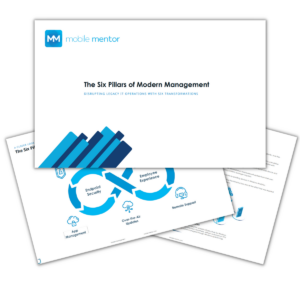If you talk to IT leaders, most will agree that achieving a functional, productive, and secure endpoint ecosystem is a moving target. Getting Modern Endpoint Management right takes a good deal of finesse, planning, and technical knowledge. However, when you successfully achieve a productive modern endpoint management program, you can effectively remove legacy constructs that make businesses vulnerable and IT departments sluggish.
At Mobile Mentor, we often refer to the Six Pillars of Modern Endpoint Management as our north star to achieve the best possible employee experience and strongest security in our endpoint ecosystem. Setting these fundamentals in place enables all facets of a business to fire efficiently. In this article, we aim to break down what each pillar of Modern Endpoint Management achieves, and how deploying all will help your business succeed in 2023 and beyond.
What Are the Pillars of Modern Endpoint Management?
The six pillars of modern endpoint management are Zero Trust Architecture (ZTA), passwordless authentication, Zero Touch Provisioning, over-the-air updates, cloud data, and remote support. Below, we explore how each pillar enriches your business and endpoint ecosystem.
Zero Trust Architecture
Deploying Zero Trust Architecture means to explicitly verify the identity and the device of every access request on an environment. It works via the principle of “assume breach”, meaning the architecture treats every access attempt as if it is a possible breach and denies access until proven otherwise. This explicit verification tactic limits exposure of breach and blast range if one does occur. It is a modern approach to security that is designed for hybrid work and BYO devices.
What Does Zero Trust Architecture Achieve?
Deploying Zero Trust removes the notion of requiring a domain. It addresses the reality that many employees work outside of an office in the post-pandemic world. Zero Trust allows for the same security to be provided to end users regardless of location – moving us past the legacy on-prem based “castle and moat” infrastructure of years past. Remote and hybrid workers are subject to the same conditional access policies, authentication experience, and access permissions as on-site workers, thus providing them with the same level of security your on-prem workers receive.
Passwordless Authentication
When we think about passwords, we must consider that the concept of a password was created all the way back in 1961. They were certainly innovative at the time, but in 2023 they are the bane of many IT teams. Companies large and small have fallen victim to phishing attacks, which target the weakest passwords in an environment.
Passwordless authentication allows us to move past the traditional username and password model and embrace technologies like biometrics, single-sign-on, and multi-factor authentication.
What does Passwordless Authentication Achieve?
Passwordless authentication enables us to become phish-resistant as it forces end-users to complete specific, unique actions in order to authenticate. This drastically reduces the volume of attempts on our environments. After all, if employees are not using passwords, they cannot be phished. This allows IT leaders to report a significant percentage of phish-resistant employees to auditors, cyber-security committees, and even insurance brokers, bolstering security posture and lowering premiums.
Zero Touch Provisioning
Zero Touch Provisioning is the ability to configure your business’ devices remotely without needing your IT team to go through the physical imaging process for machines. It can be applied to the five most prominent kinds of devices used which include Windows OS, iOS, iPadOS, macOS, and Android.
What does Zero Touch Provisioning Achieve?
Zero Touch Provisioning removes the time-intensive and logistically complex process of manual imaging devices for employees. For years, IT teams have been burdened with manual imaging which has resulted in a costly usage of time.
Zero Touch Provisioning significantly streamlines the onboarding process and allows IT team to leverage Intune for out-of-box provisioning for remote, hybrid, and onsite end users alike.
Cloud Data
Cloud data has emerged as a fundamental pillar of modern endpoint management, changing the way organizations handle their data resources. One of the key advantages is its ability to eliminate the need for on-premise storage infrastructure, liberating companies from the task of maintaining and scaling physical servers. This shift to cloud-based data storage not only reduces overhead costs but also enhances the agility and scalability of endpoint management. With data stored securely in the cloud, businesses can seamlessly adapt to changing storage demands without the constraints of physical hardware limitations.
What does Cloud Data Achieve?
The shift to cloud-based data storage not only reduces overhead costs but also enhances the agility and scalability of endpoint management. With data stored securely in the cloud, businesses can seamlessly adapt to changing storage demands without the constraints of physical hardware limitations.
The integration of cloud data into endpoint management also brings a host of collaborative benefits. Live document collaboration, a cornerstone of cloud-based systems, enables teams to work simultaneously on shared files from diverse locations. This real-time collaboration fosters increased productivity and creativity, as members can collectively contribute to projects without the limitations of time zones or geographical barriers.
Additionally, the cloud’s automatic backup capabilities provide an extra layer of data protection, ensuring that critical information remains safe from accidental loss or hardware failures. This alleviates the need for manual backups and significantly reduces the risk of data disruptions. As a result, cloud data empowers organizations to bid farewell to traditional Virtual Private Networks (VPNs), as employees can securely access and collaborate on documents from anywhere, further streamlining modern endpoint management practices.
Modern App Management
With Modern App Management, applications are deployed based on assigned group membership in Intune. It allows IT departments to decide when apps are pushed and which are available internally.
What does Modern App Management Achieve?
Modern app management achieves a more secure posture for your business’ data. Additionally, it reduces Zero Day Exposures via policy. Modern App Management will also streamline deployment to end users and by doing so increase efficiency.
Over-the-Air Updates
Keeping devices up to date can be a challenge for IT departments – especially those with remote employees. Deploying regular OS updates offers many benefits including the patching of security flaws, obtaining feature updates, and performance improvements.
What do over-the-air updates achieve?
Over-the-air updates allow us to do away with VPNs. Although popular in the 90s and early 00s, VPNs no longer provide the secure access to an environment that modern workplaces need. In fact, many businesses are finding VPNs to be a critical liability and security vulnerability.
With over-the air-updates, the need for an end-user to access a VPN to pull down an update is eliminated and devices are able to regularly maintain their health and functionality.
Remote Support
Remote support is comprised of remote support agents who support remote employees. A remote support program will reinforce security and usability for a variety of devices, including laptops, tablets, and smartphones, whether they are corporately owned or BYO devices.
What does remote support achieve?
Remote IT support removes the friction that once existed between remote workers and office-based IT. Remote IT workers are able to resolve issues on a remote worker’s device creating a better employee experience for teams.
Conclusion
Getting Modern Endpoint Management right means finding an excellent balance between security and user experience. When executed correctly, it provides security that is invisible to end-users and a frictionless relationship between remote IT professionals and the employees they support.
Achieving this balance is possible with the correct planning, an experienced team, and application of Microsoft 365 technologies. To find out more about what it takes to get your Modern Endpoint Management program moving forward in the right direction, check out the video advice from our team of experts or download our complete guide on the Six Pillars of Modern Endpoint Management.
Download Our Guide to the 6 Pillars of Modern Endpoint Management
 Download our extensive, whitepaper that outlines how to practically disrupt legacy IT operations with six transformations. We’ll address:
Download our extensive, whitepaper that outlines how to practically disrupt legacy IT operations with six transformations. We’ll address:
-
Do we manually provision every Windows device?
-
Are we still dealing with passwords for devices and apps?
-
Do we spend so much time keeping devices updated?
-
Do we still run on-premise servers and data centers?
-
Do we still need a VPN to access company resources?
-
Are we still providing local, on-site, IT support services?




